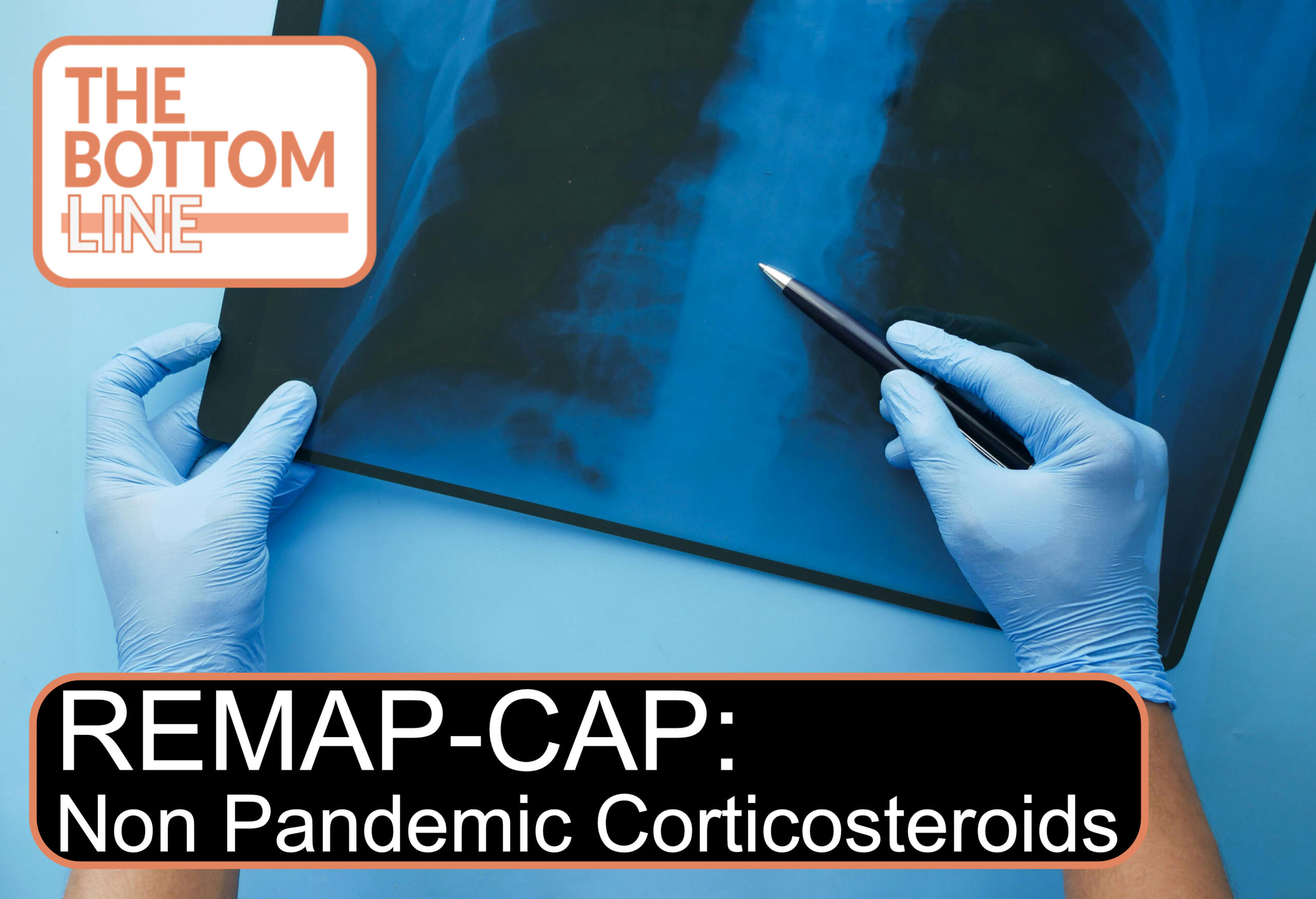REMAP CAP: Corticosteroids
 Effect of hydrocortisone on mortality in patients with severe community-acquired pneumonia: The REMAP-CAP Corticosteroid Domain Randomized Clinical Trial
Effect of hydrocortisone on mortality in patients with severe community-acquired pneumonia: The REMAP-CAP Corticosteroid Domain Randomized Clinical Trial
Angus. ICM 2025; doi: https://doi.org/10.1007/s00134-025-07861-w
Clinical Question
- In adult patients with severe community acquired pneumonia (CAP) requiring ICU admission, does a 7-day course of intravenous hydrocortisone reduce 90-day mortality?
Background
- Community-acquired pneumonia (CAP) remains a leading cause of ICU admissions and mortality
- Corticosteroids may reduce mortality through their anti-inflammatory properties, potentially reducing organ damage from excessive host inflammatory responses and mitigating septic shock via effects on the renin-angiotensin-aldosterone axis
- Previous studies have shown mixed results regarding corticosteroid efficacy in severe CAP.
- Recent guidelines now recommend corticosteroid administration for severe CAP, but uncertainty persists regarding optimal type, dose, and patient selection
Design
- Study type: International adaptive randomized controlled platform trial
- Randomization: Balanced assignment initially, then response-adaptive allocation based on accumulating evidence
- Blinding: Open-label design
- Stratification: Treatment effects estimated separately for patients with/without vasopressor-dependent shock and with/without influenza
- Complex statistical framework:
- Bayesian hierarchical model with response-adaptive randomization
- Stopping rules: Pre-specified criteria for superiority (>99% probability OR<1), futility (<5% probability of >20% reduction), and inferiority
- The primary model was adjusted for multiple covariates including location, age, sex, shock, influenza and degree of respiratory compromise. The model used information not only from those randomised to hydrocortisone or control, but from all patients randomised who met severe CAP criteria regardless of whether patients were included in the corticosteroid domain
- The non pandemic corticosteroid domain compared several interventions including fixed duration hydrocortisone, shock dependent hydrocortisone, fixed duration dexamethasone and control (no steroid)
- The 7 day fixed duration hydrocortisone met stopping criteria so this report only compares this arm vs control
Setting
- 101 sites across 18 countries
- Geographic distribution: Australia (57%), Europe (33%), North America (7%), Asia (3%)
- March 11, 2018 to December 6, 2023
Population
- Inclusion:
- Adults ≥18 years with community-acquired pneumonia
- CAP defined as signs and symptoms consistent with lower respiratory tract infection and radiological evidence of new-onset infiltrate of infective origin
- ICU admission within 48 hours of hospital presentation for respiratory or cardiovascular organ support
- Respiratory support: invasive/non-invasive ventilation or high-flow nasal cannula (≥30 L/min, FiO₂ ≥0.4)
- Cardiovascular support: intravenous vasopressor or inotrope
- Exclusion:
- Nursing home residents or recent healthcare facility inpatients
- Known/presumed COVID-19 infection
- Known hypersensitivity to corticosteroids
- Chronic systemic corticosteroid use
- 24 hours since ICU admission
- 658 patients (536 hydrocortisone, 122 control) enrolled
- A total of 3,990 enrolled in pandemic domain, and of those 945 enrolled in corticosteroid domain
- The remaining 3,045 were eligible for inclusion in the model for covariate adjustment
- Imbalance in randomisation due to two factors:
- 1/3rd patients assigned for fixed duration hydrocortisone were randomised at sites that offered > 1 steroid intervention but no control due to perceived lack of equipoise
- Erroneous labelling in first adaptive analysis resulted in response adaptive randomisation proportions assigning more patients to fixed duration hydrocortisone
- A total of 3,990 enrolled in pandemic domain, and of those 945 enrolled in corticosteroid domain
- Comparing baseline characteristics of hydrocortisone vs. control group
- Age: 62.5 vs 58.5 years
- Female: 38% vs 44%
- Ethnicity:
- White 73% vs 63%
- Asian 6% vs 2
- APACHE II: 18 vs 18
- Time to enrolment from hospital admission: 0.8 vs 0.8 days
- Respiratory Support
- IMV: 40% vs 38%
- NIV: 14% vs 17%
- HFNC: 38% vs 33%
- P/F Ratio: 156 vs 168
- Baseline co-morbidities:
- Diabetes: 30% vs 22%
- Kidney Disease: 14% vs 22%
- Strata:
- Shock, Influenza: 5% vs 3%
- Shock, No Influenza: 44% vs 44%
- No Shock, Influenza: 4% vs 4%
- No Shock, No Influenza: 47% vs 48%
Intervention
- Intravenous hydrocortisone 50 mg every 6 hours for 7 days
- No tapering required
- Discontinued at hospital discharge if before 7 days
- 99% (527/533) received at least one dose
- Median duration: 7 days (IQR 4-8)
Control
- No corticosteroids
- 23% (28/122) received systemic corticosteroids for clinical indications
- Median duration when used: 4 days (IQR 2-5.3)
- Only 1 patient (0.8%) received full-dose equivalent treatment
Management common to both groups
- Systemic corticosteroid therapy permitted in all patients if new clinical indications developed for established corticosteroid treatments (post-extubation stridor, bronchospasm, anaphylaxis)
- Other aspects of care provided as per each site’s standard practice
Outcome
- Primary outcome:
- 90 day mortality
- Hydrocortisone: 15.0% (78/521) vs Control: 9.8% (12/122)
- Median adjusted odds ratio: 1.56 (95% CrI 0.80 – 3.31)
- Probability of superiority (OR < 1): 10%
- Adjusted odds ratios by strata:
- Vasopressor-dependent shock, influenza:
- 1.52 (95% CrI 0.69-3.56)
- Probability of superiority (OR < 1): 15.7%
- Vasopressor-dependent shock, no influenza:
- 1.53 (95% CrI 0.76-3.29)
- Probability of superiority (OR < 1): 12.1%
- Influenza, no vasopressor-dependent shock:
- 1.62 (95% CrI 0.73-3.84)
- Probability of superiority (OR < 1): 12.6%
- No influenza, no vasopressor-dependent shock:
- 1.63 (95% CrI 0.80-3.59)
- Probability of superiority (OR < 1): 9.2%
- Vasopressor-dependent shock, influenza:
- Secondary outcomes:
- Significantly lower duration of cardiovascular support in hydrocortisone group:
- Median 2 vs 3 days (p=0.05)
- Probability of superiority:
- ICU mortality: 9.3% vs 5.7%
- Probability of superiority (OR < 1): 19.3%
- ICU length of stay: 5 vs 5.5 days
- Probability of superiority (OR < 1): 32.3%
- Hospital length of stay: 12 vs 14 days
- Probability of superiority (OR < 1): 29.7%
- Organ Support Free Days: 24 vs 22.5 days
- Probability of superiority (OR < 1): 85.4%
- Ventilator-free days: 27 vs 28 days
- Probability of superiority (OR < 1): 72.8%
- Serious adverse events: 1.3% vs 0.8%
- ICU mortality: 9.3% vs 5.7%
- Significantly lower duration of cardiovascular support in hydrocortisone group:
Authors’ Conclusions
- Among patients with severe CAP, treatment with a 7-day fixed-duration course of hydrocortisone, compared with no hydrocortisone, appears unlikely to yield a large reduction in mortality. Smaller benefits and possible harm are not excluded
Strengths
- Robust design:
- Adaptive platform trial with Bayesian statistical framework allowing efficient evaluation
- Borrowing of data across domains allows for better estimation of covariate effects
- International scope: Multi-center trial across 18 countries enhances generalizability
- Sample size: Large cohort
- Low loss to follow-up: 97.7% completeness for primary outcome
- Intervention fidelity: High compliance with protocol (99% received intervention)
- Contemporary patient population: Reflects current ICU practice for severe CAP
- Pre-specified analysis plan: Clear stopping rules and statistical approach minimize bias
Weaknesses
- Unblinded design: Open-label nature may influence clinical decisions and outcomes
- Imbalanced randomization: Data coding error led to more patients assigned to hydrocortisone arm
- Control group contamination: 23% of control patients received corticosteroids – 28/122 patients with a median treatment course of 4 days
- Baseline imbalances: Hydrocortisone group appear slightly sicker (older, worse respiratory function)
- Limited numbers in some strata: Small numbers of influenza patients enrolled leading to inconclusive findings in this group
- Site variation: Not all sites offered all treatment options, however statistical design aims to account for this
The Bottom Line
- This large, adaptive platform trial suggests that routine use of a 7-day course of hydrocortisone does not improve mortality, and may potentially harm, patients with severe community-acquired pneumonia requiring ICU admission
- These results challenge recent guideline recommendations for corticosteroids in severe CAP
External Links
Metadata
Summary author: Louise Connell
Summary date: 7th August 2025
Peer-review editor: George Walker
Picture by: Towfiqua Barbhuiya / Pexels



